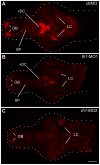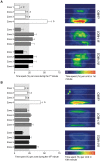Transient knockdown of tyrosine hydroxylase during development has persistent effects on behaviour in adult zebrafish (Danio rerio)
- PMID: 22879998
- PMCID: PMC3411795
- DOI: 10.1371/journal.pone.0042482
Transient knockdown of tyrosine hydroxylase during development has persistent effects on behaviour in adult zebrafish (Danio rerio)
Abstract
Abnormal dopamine (DA) signaling is often suggested as causative in schizophrenia. The other prominent hypothesis for this disorder, largely driven by epidemiological data, is that certain adverse events during the early stages of brain development increase an individual's risk of developing schizophrenia later in life. However, the clinical and preclinical literature consistently implicates behavioural, cognitive, and pharmacological abnormalities, implying that DA signaling is abnormal in the adult brain. How can we reconcile these two major hypotheses underlying much of the clinical and basic research into schizophrenia? In this study we have transiently knocked down tyrosine hydroxylase (TH, the rate limiting enzyme in DA synthesis) gene expression in the early stages of brain development in zebrafish using morpholinos. We show that by adulthood, TH and DA levels have returned to normal and basic DA-mediated behaviours, such as locomotion, are also normal. However, when they were exposed to a novel environment the levels of freezing and immediate positioning in deeper zones were significantly reduced in these adult fish. The neurochemistry underlying these behaviours is complex, and the exact mechanisms for these abnormal behaviours remains unknown. This study demonstrates that early transient alterations in DA ontogeny can produce persistent alterations in adult brain function and suggests that the zebrafish may be a promising model animal for future studies directed at clarifying the basic neurodevelopmental mechanisms behind complex psychiatric disease.
Conflict of interest statement
Figures







Similar articles
-
Embryonic exposure to valproic acid affects the histaminergic system and the social behaviour of adult zebrafish (Danio rerio).Br J Pharmacol. 2018 Mar;175(5):797-809. doi: 10.1111/bph.14124. Epub 2018 Jan 23. Br J Pharmacol. 2018. PMID: 29235100 Free PMC article.
-
Expression of the paralogous tyrosine hydroxylase encoding genes th1 and th2 reveals the full complement of dopaminergic and noradrenergic neurons in zebrafish larval and juvenile brain.J Comp Neurol. 2010 Feb 15;518(4):423-38. doi: 10.1002/cne.22213. J Comp Neurol. 2010. PMID: 20017209 Free PMC article.
-
Delayed effects of methylmercury on the mitochondria of dopaminergic neurons and developmental toxicity in zebrafish larvae (Danio rerio).Aquat Toxicol. 2016 Jun;175:73-80. doi: 10.1016/j.aquatox.2016.03.004. Epub 2016 Mar 7. Aquat Toxicol. 2016. PMID: 26994370
-
Non-dopaminergic neurons partly expressing dopaminergic phenotype: distribution in the brain, development and functional significance.J Chem Neuroanat. 2009 Dec;38(4):241-56. doi: 10.1016/j.jchemneu.2009.08.004. Epub 2009 Aug 19. J Chem Neuroanat. 2009. PMID: 19698780 Review.
-
Environment- and activity-dependent dopamine neurotransmitter plasticity in the adult substantia nigra.J Chem Neuroanat. 2016 Apr;73:21-32. doi: 10.1016/j.jchemneu.2015.12.009. Epub 2015 Dec 21. J Chem Neuroanat. 2016. PMID: 26718607 Review.
Cited by
-
The Role of Zebrafish and Laboratory Rodents in Schizophrenia Research.Front Psychiatry. 2020 Aug 27;11:703. doi: 10.3389/fpsyt.2020.00703. eCollection 2020. Front Psychiatry. 2020. PMID: 33101067 Free PMC article. Review.
-
Pdgf signalling guides neural crest contribution to the haematopoietic stem cell specification niche.Nat Cell Biol. 2017 May;19(5):457-467. doi: 10.1038/ncb3508. Epub 2017 Apr 10. Nat Cell Biol. 2017. PMID: 28394883 Free PMC article.
-
Kisspeptin-1 regulates forebrain dopaminergic neurons in the zebrafish.Sci Rep. 2020 Nov 9;10(1):19361. doi: 10.1038/s41598-020-75777-0. Sci Rep. 2020. PMID: 33168887 Free PMC article.
-
Computational approaches for understanding the diagnosis and treatment of Parkinson's disease.IET Syst Biol. 2015 Dec;9(6):226-33. doi: 10.1049/iet-syb.2015.0030. IET Syst Biol. 2015. PMID: 26577157 Free PMC article.
References
-
- Lewis SW, Murray RM (1987) Obstetric complications, neurodevelopmental deviance, and risk of schizophrenia. J Psychiatr Res 21: 413–421. - PubMed
-
- Weinberger DR (1987) Implications of normal brain development for the pathogenesis of schizophrenia. Arch Gen Psychiatry 44: 660–669. - PubMed
-
- Lewis DA, Levitt P (2002) Schizophrenia as a disorder of neurodevelopment. Annu Rev Neurosci 25: 409–432. - PubMed
-
- Rapoport JL, Addington AM, Frangou S, Psych MR (2005) The neurodevelopmental model of schizophrenia: update 2005. Mol Psychiatry 10: 434–449. - PubMed
Publication types
MeSH terms
Substances
LinkOut - more resources
Full Text Sources
Other Literature Sources
Medical
Molecular Biology Databases

